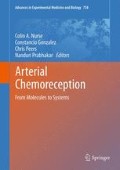Abstract
Exposure to prolonged hypobaric hypoxia increases baseline ventilation and the ventilatory response to acute hypoxia, a phenomenon known as hypoxic ventilatory acclimatization (HVA). It is currently accepted that the carotid bodies and the reduced PO2 levels are key elements in the generation of the HVA. However, because most of these experiments have been performed in hypobaric conditions, we studied the effects of 15 days of chronic normobaric hypoxia (CNH) on the rabbit ventilatory responses to hypoxia and chemoexcitatory molecules. New Zealand White rabbits were placed in a 0.3 m³ chamber with controlled temperature and a mean O2 content of 9.17 ± 0.09 %. Animals with or without CNH exposition (naïve) were anesthetized (ketamine/xylazine 75/7.5 mg/kg, i.m.), cannulated and air flow was measured. In naïve animals hypoxic challenges and NaCN increase ventilation, effect completely abolished after bilateral chemodenervation. However, ventilatory responses to nicotine, ATP and dopamine remained largely unchanged after bilateral chemodenervation, suggesting a centrally mediated effect for these drugs. Basal ventilation was reduced in CNH animals, but the dose dependent ventilatory increases induced by NaCN presented an increased sensibility. Further experiments are needed to elucidate the mechanisms responsible for these acclimatized responses.
Access this chapter
Tax calculation will be finalised at checkout
Purchases are for personal use only
References
Aaron EA, Powell FL (1993) Effect of chronic hypoxia on hypoxic ventilatory response in awake rats. J Appl Physiol 74:1635–1640
Baker JE, Curry BD, Olinger GN, Gross GJ (1997) Increased tolerance of the chronically hypoxic immature heart to ischemia Contribution of the KATP channel. Circulation 95:1278–1285
Barnard P, Andronikou S, Pokorski M, Smatresk N, Mokashi A, Lahiri S (1987) Time-dependent effect of hypoxia on carotid body chemosensory function. J Appl Physiol 63:685–691
Bisgard GE (2000) Carotid body mechanisms in acclimatization to hypoxia. Respir Physiol 121:237–246
Bisgard GE, Busch MA, Forster HV (1986a) Ventilatory acclimatization to hypoxia is not dependent on cerebral hypocapnic alkalosis. J Appl Physiol 60:1011–1015
Bisgard GE, Busch MA, Daristotle L, Berssenbrugge AD, Forster HV (1986b) Carotid body hypercapnia does not elicit ventilatory acclimatization in goats. Respir Physiol 65:113–125
Bouverot P, Candas V, Libert JP (1973) Role of the arterial chemoreceptors in ventilatory adaptation to hypoxia of awake dogs and rabbits. Resp Physiol 17:209–219
Chalmers JP, Korner PI, White SW (1967) The relative roles of the aortic and carotid sinus nerves in the rabbit in the control of respiration and circulation during arterial hypoxia and hypercapnia. J Physiol 188:435–450
Chen J, He L, Dinger B, Stensaas L, Fidone S (2002) Role of endothelin and endothelin a-type receptor in adaptation of the carotid body to chronic hypoxia. Am J Physiol Lung Cell Mol Physiol 282:L1314–L1324
Docherty RJ, McQueen DS (1979) The effects of acetylcholine and dopamine on carotid chemosensory activity in the rabbit. J Physiol 288:411–423
Dwinell MR, Powell FL (1999) Chronic hypoxia enhances the phrenic nerve response to arterial chemoreceptor stimulation in anesthetized rats. J Appl Physiol 87:817–823
Harcourt-Brown FM, Baker SJ (2001) Parathyroid hormone, haematological and biochemical parameters in relation to dental disease and husbandry in rabbits. J Small Anim Pract 42:130–136
He L, Dinger B, Fidone S (2005) Effect of chronic hypoxia on cholinergic chemotransmission in rat carotid body. J Appl Physiol 98:614–619
Kääb S, Migel-Velado E, López-López JR, Pérez-García MT (2005) Down regulation of Kv3.4 Channels by chronic hypoxia increases acute oxygen sensitivity in rabbit carotid body. J Physiol Lond 566:395–408
Korner PI, Edwards AWT (1960) The immediate effects of acute hypoxia on the heart rate, arterial pressure, cardiac output and ventilation of the unanaesthetized rabbit. Exp Physiol 45:113–122
Matsumoto S (1986) Effects of carotid body chemoreceptor stimulating and depressing agents on internal intercostal muscle activity in the rabbit. Jap J Physiol 36:1001–1013
Ponte J, Sadler CL (1989) Interactions between hypoxia, acetylcholine and dopamine in the carotid body of rabbit and cat. J Physiol 410:395–410
Powell FL, Dwinell MR, Aaron EA (2000a) Measuring ventilatory acclimatization to hypoxia: comparative aspects. Respir Physiol 122:271–284
Powell FL, Huey KA, Dwinell MR (2000b) Central nervous system mechanisms of ventilatory acclimatization to hypoxia. Respir Physiol 121:223–236
Stea A, Jackson A, Macintyre L, Nurse CA (1995) Long-term modulation of inward currents in O2 chemoreceptors by chronic hypoxia and cyclic AMP in vitro. J Neurosci 15:2192–2202
Acknowledgements
Study supported by Grant 1090157 from the Fondo Nacional de Desarrollo Científico y Tecnológico (FONDECYT), Chile.
Author information
Authors and Affiliations
Corresponding author
Editor information
Editors and Affiliations
Rights and permissions
Copyright information
© 2012 Springer Science+Business Media Dordrecht
About this paper
Cite this paper
Alcayaga, J., Del Rio, R., Moya, E.A., Freire, M., Iturriaga, R. (2012). Rabbit Ventilatory Responses to Peripheral Chemoexcitators: Effects of Chronic Hypoxia. In: Nurse, C., Gonzalez, C., Peers, C., Prabhakar, N. (eds) Arterial Chemoreception. Advances in Experimental Medicine and Biology, vol 758. Springer, Dordrecht. https://doi.org/10.1007/978-94-007-4584-1_42
Download citation
DOI: https://doi.org/10.1007/978-94-007-4584-1_42
Published:
Publisher Name: Springer, Dordrecht
Print ISBN: 978-94-007-4583-4
Online ISBN: 978-94-007-4584-1
eBook Packages: Biomedical and Life SciencesBiomedical and Life Sciences (R0)

